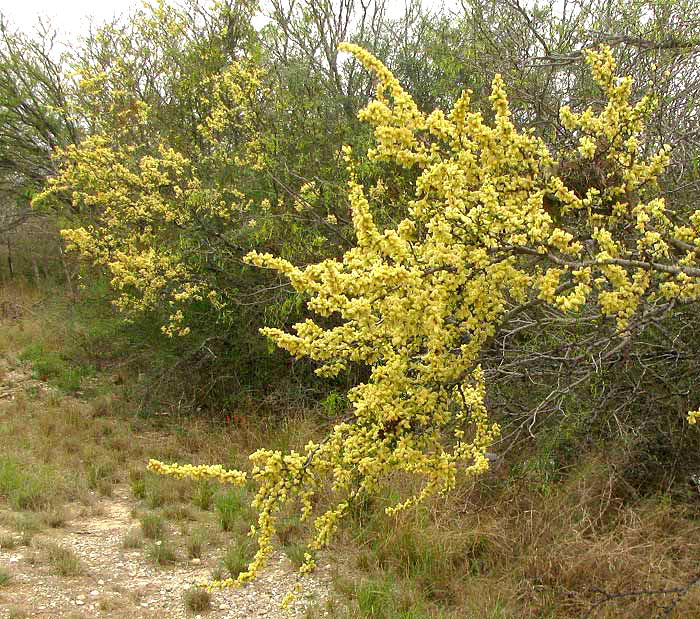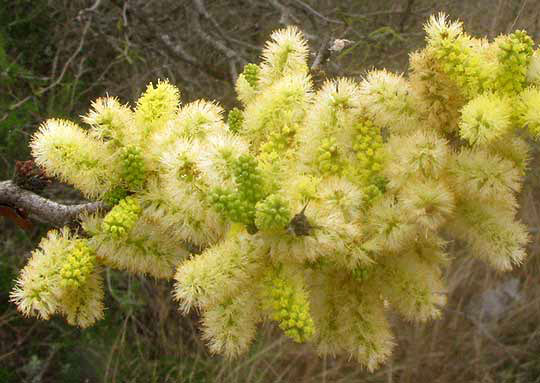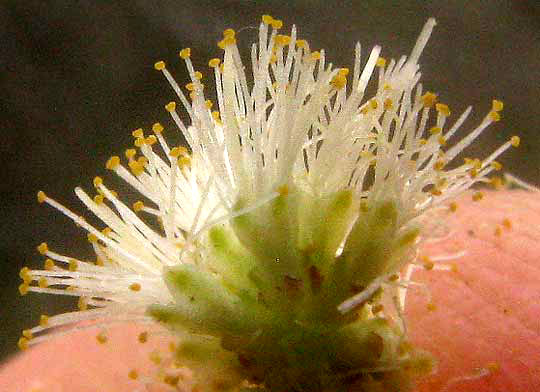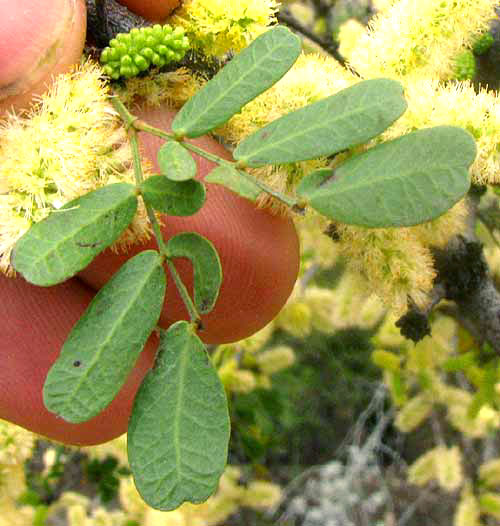Excerpts from Jim Conrad's
Naturalist Newsletter

from the March 30, 2014 Newsletter issued from the Frio Canyon Nature Education Center in the valley of the Dry Frio River in northern Uvalde County, southwestern Texas, on the southern border of the Edwards Plateau; elevation ~1750m (~5750 ft); N29.62°, W99.86°; USA
BLACKBRUSH FLOWERING
In the scrub forest north of Uvalde, flowering Spanish Daggers are the most spectacular presences, but a close second is one of several acacia species found in the area, which right now is flowering in gorgeous, bee-hummed bountifulness. Some flowery branches at the edge of the scrub reaching toward US 83 are shown above.
Up close you see that the flowers are tiny, but multitudes of them are crammed onto spikes, and the spikes themselves cluster tightly, as shown below:

A close-up of a few individual flowers at the tip of a spike shows that from the bowl formed of calyx and corolla, more than ten stamens with their slender, white filaments and tiny, yellow, spherical anthers arise from each flower,below:

Each leaf of this small tree is twice-pinnate, as shown below:

That picture shows one leaf. Its first division produces two segments which are attached to their common petiole extending from the picture's upper, left corner. Then each of those two divisions is further divided into six individual leaflets, or pinnae.
When you see this combination of features -- numerous stamens arising from each flower, and twice-pinnate leaves -- probably you're dealing with an acacia. In the old days, acacias belonged to the genus Acacia, but in 2005 someone screwed up a good thing so that now most serious institutions place them in the genus Vachellia. However, older field guides and most experts in Texas seem to continue using Acacia, so you're likely to find our magnificent little tree designated either as Acacia rigidula, or VACHELLIA RIGIDULA. Commonly it goes by the names Blackbush, Blackbush Acacia, Catclaw, Chaparro Prieto, Gavia and other names.
Ranchers in this area are likely to grub Blackbush from their land because grass for cattle could grow where it grows, and because it's been noticed that livestock grazing on Blackbush leaves in the fall sometimes show erratic behavior, such as "limber leg," where the animals stumble around. Noting this, researchers at Texas A & M University analyzed Blackbush and found it to contain toxic substances such as amphetamines. Amphetamines often are used by humans as weight-control supplements, so a whole new industry was born. If you Google "Acacia rigidula," the top of the resulting page will feature bottles of various herbal medicines for sale, all saying they contain Acacia rigidula. The pills not only are sold for weight loss, but also to boost energy and stabilize moods.
Blackbush occupies disturbed sites such as fencerows, as well as rocky slopes and bluffs, and along arroyos mostly in arid northeastern Mexico, but extending into the US in southern Texas. It's common on the flat, Coastal Plain around Uvalde, but I've not seen it here on the limy soils of the southern slope of the Edwards Plateau.